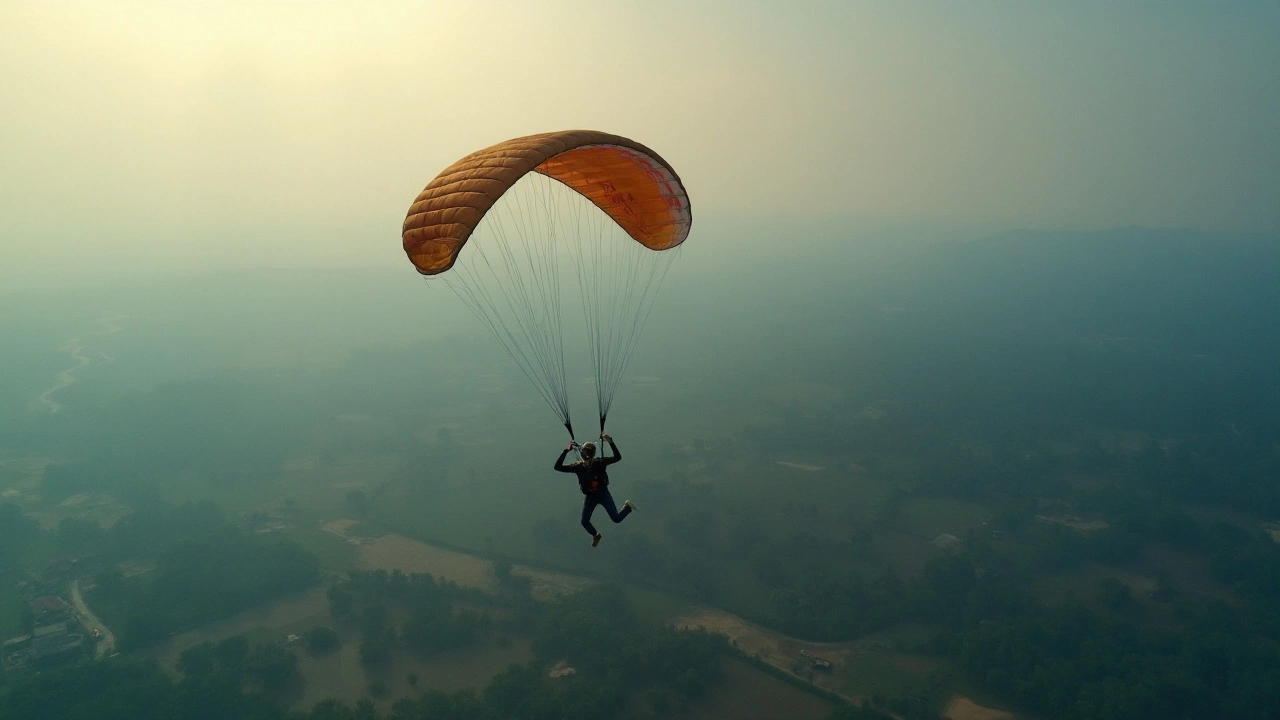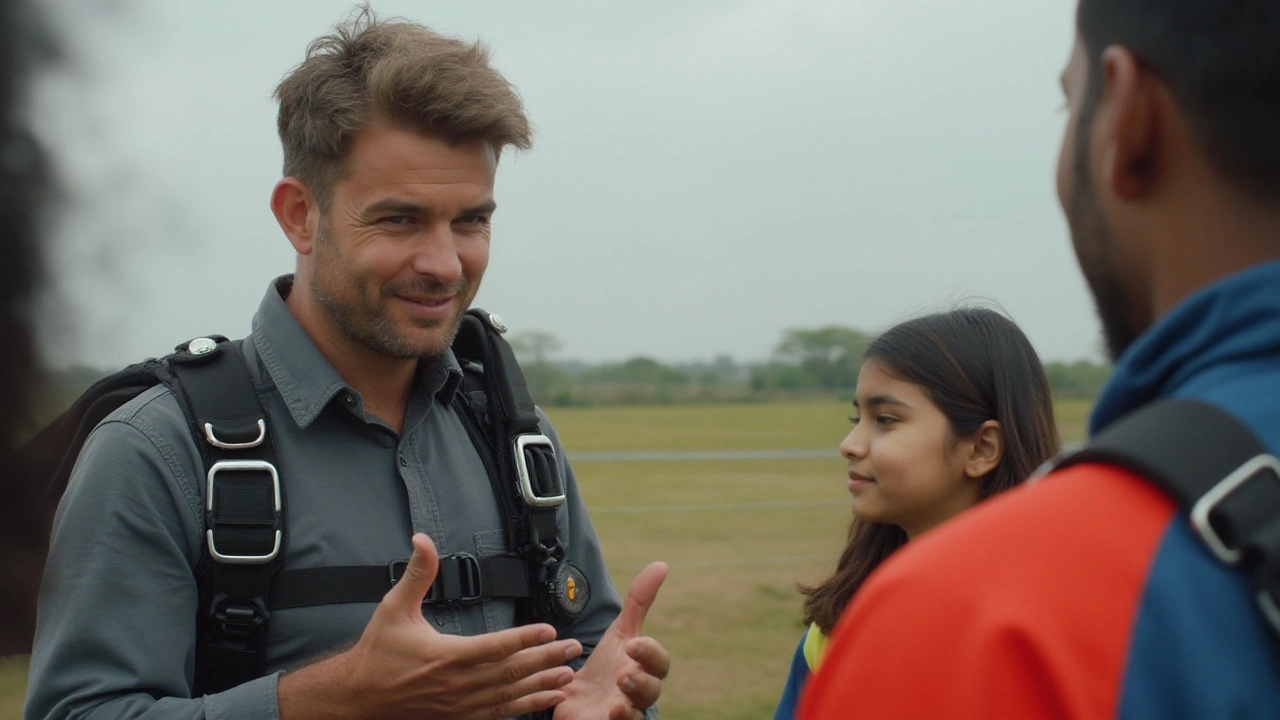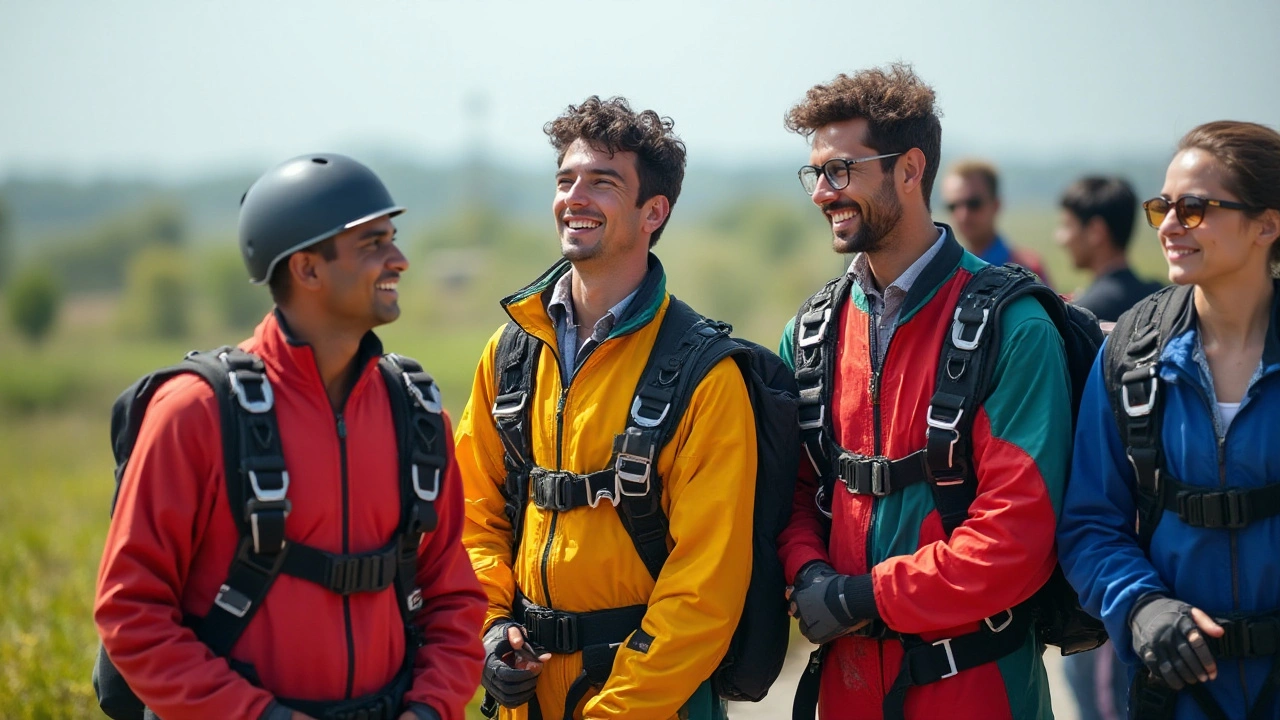Skydiving is not just a sport; it’s an experience that combines the thrill of freefall with the serenity of parachuting back to the earth. With the wind rushing past and the world unfolding beneath, skydiving captures the spirits of adventure enthusiasts globally. But with any extreme sport, the question of safety is paramount, especially when contemplating a leap from thousands of feet above the ground.
In recent years, advances in equipment and training have made skydiving safer than ever before. Still, it remains crucial to understand the risks involved, as well as the safety measures that are in place, particularly if you're considering trying this thrilling sport in India. Knowledge of skydiving statistics can demystify the fears associated with it and can be the key to enjoying a secure yet exhilarating adventure.
- Skydiving: An Overview
- Statistics and Safety Measures
- Common Misconceptions
- Top Destinations in India
- Tips for Safe Skydiving
Skydiving: An Overview
Skydiving has long attracted adventurers eager to experience the freedom and adrenalin rush it offers. Rooted in the history as a military exercise developed for troop deployment, this extreme sport has evolved into a popular recreational activity enjoyed by thrill-seekers worldwide. As an activity defined by leaping from an aircraft and enjoying freefall before deploying a parachute, skydiving provides an unparalleled perspective of the world, one that is both visceral and awe-inspiring.
The equipment used in skydiving is meticulously designed for safety and reliability. Modern parachutes are crafted from strong, lightweight fabric, often made of a ripstop nylon, which ensures durability. The parachutes are attached to containers worn on the back, with additional safety devices such as automatic activation devices (AADs) which deploy the parachute when a skydiver reaches a predetermined altitude. Jumping with a trained instructor is usually how beginners start, with tandem jumps being the most prevalent for first-timers.
Training is a vital part of the skydiving experience, with rigorous adherence to established protocols ensuring that jumps are performed safely. The globally renowned United States Parachute Association (USPA) outlines comprehensive guidelines that are respected across borders. In India, similar standards are followed through local licensing authorities that oversee training and certification for skydiving enthusiasts. Despite its daring nature, statistics suggest skydiving remains relatively safe. Data from USPA indicates an estimated fatality rate of 0.39 per 100,000 jumps, a testament to the improved safety measures embraced by the sport over recent decades.
"Skydiving is a unique sport that grants you the freedom of the skies," says Jeb Corliss, a professional skydiver known for his breathtaking stunts.
The adventure sport is cherished in diverse locales across India, offering breathtaking views coupled with the thrill of the jump. Locations for skydiving in India such as Mysore, Aamby Valley, and Deesa are gaining popularity, inviting both locals and tourists to indulge in this airborne venture. Each place offers unique experiences with defined safety measures to ensure participants have a memorable yet secure dive. As more people become aware of the safety protocols and the thrill this sport offers, skydiving continues to grow in popularity, serving as a symbol of courage and exploration for those daring enough to leap into the unknown.
Statistics and Safety Measures
Skydiving has always been perceived as a high-risk activity, but advancements in technology and stricter regulations have significantly mitigated these risks. In recent years, the skydiving safety record has improved remarkably. According to the United States Parachute Association (USPA), the fatality rate for skydiving is approximately 0.39 deaths per 100,000 jumps. This statistic offers a concrete representation of how skydiving compares to other adventure sports, making it statistically safer than activities like scuba diving or even marathon running. However, to someone unfamiliar with the sport, these numbers still might seem daunting, which is why it's essential to understand the nuanced efforts behind these safety measures.
A significant factor contributing to skydiving’s enhanced safety is rigorous training protocols. Potential skydivers must undergo comprehensive training programs, which include theory, practical sessions, and safety drills. This training is crucial in preparing individuals to handle situations such as parachute malfunctions. Additionally, skydiving gear has evolved tremendously over the years. Modern parachutes are designed for ease of control, helping even beginners master their descent. Backup automatic activation devices (AAD) are a standard feature, automatically deploying the reserve parachute if the main one is not activated at a safe altitude. These systems have proven to be life-saving in critical scenarios.
Another layer of safety is added by the highly regulated operations of certified drop zones. These are locations where skydiving takes place under supervised conditions with expert instructors. The International Skydiving Commission (ISC) regularly updates operational procedures, equipment standards, and instructional methods to minimize risks associated with skydiving. Notably, all instructors must hold necessary certifications and are subject to continuous assessments to ensure they maintain a high standard of practice.
Yet, despite these extensive measures, some have labeled skydiving's freedom and thrill with fatalism, ignoring the vast networks of safety and emergency protocols. To dispel myths, it is critical for the public to understand the diligence of skydiving associations worldwide in creating safe environments. As John LeBlanc, a noted parachute designer, has said,
"Skydiving is a disciplined sport, and it rewards those who respect it. Technology and human ingenuity have taken what was once truly dangerous and made it just an exhilarating experience."Keeping his words in mind, it's clear that the sport can be safely enjoyed when approached with respect and adherence to safety guidelines.
Furthermore, informed consent plays a pivotal role. Skydivers are educated about potential risks and safety protocols, ensuring they understand and accept responsibility. With all these precautions, skydiving continues to appeal to adventure enthusiasts looking for safe, yet adrenaline-pumping experiences in adventure sports India. Knowledge and preparation, combined with an appreciation for the craft, promise not just survival, but an adventure that leaves a lasting impact.

Common Misconceptions
Skydiving evokes a blend of excitement and apprehension, often surrounded by a cloud of misconceptions. One prevalent myth is that skydiving is overwhelmingly dangerous compared to other adventure sports. This perception largely results from dramatic depictions in movies and media, which can exaggerate the risks involved. However, in reality, the skydiving safety protocols have evolved significantly, leading to a reduced skydiving fatality rate. For perspective, statistics from the United States Parachute Association show that in 2022 there were just 10 fatalities out of approximately 3 million jumps, indicating a fatality rate of 0.3 per 100,000 jumps.
Another often-believed notion is that you need to be in top physical shape to try skydiving. While maintaining good health is important, skydiving doesn't require the fitness level of an elite athlete. In fact, people of various ages and a wide range of physical fitness backgrounds enjoy skydiving safely. Training programs are specifically designed to cater to diverse participants, focusing on safety and technique. Beginners are thoroughly guided, ensuring they are mentally and physically prepared for the jump. It's worth noting that health conditions that could complicate your experience should be discussed with medical professionals first.
Many also falsely assume that skydiving equipment is unreliable or frequently malfunctions. In truth, stringent regulations govern the design, maintenance, and operation of parachuting gear globally. Rigorous testing ensures that parachutes and harnesses can withstand immense pressure. Furthermore, modern parachutes are designed with two canopies: a primary and a reserve, in case the first fails, adding a crucial layer of safety. As technology continues to advance, equipment reliability has enhanced dramatically, providing peace of mind to both novice and experienced skydivers.
There's often a fear that the freefall experience is unpleasantly fast, leaving no time to enjoy the jump. In actuality, while freefall speeds can reach up to 120 miles per hour, the sensation is far different than anticipated. Skydivers feel more of a floating than falling sensation due to the rush of air. The whole experience lasts between 30 to 60 seconds, followed by several minutes of peaceful descent once the parachute opens. This combination of adrenaline and tranquility is precisely what draws adventurers to the sport, offering a unique contrast to everyday life experiences.
Lastly, some believe skydiving needs to be an individual activity, but surprisingly it's a highly social endeavor. Skydiving communities are known for their camaraderie and support. Those pursuing certifications often train together and build lasting friendships. For those interested in exploring adventure sports India, various locations offer tandem skydives, allowing beginners to dive alongside seasoned instructors. This often serves as an introduction to a welcoming community, making the experience as much about people as it is about the sport itself.
"Skydiving is one of the safest adrenaline things you can do. The equipment and training today are exceptionally reliable," said John Kallend, a skydiving safety expert.
Top Destinations in India
India, with its vast and varied landscape, offers some unique backdrops for skydiving enthusiasts. From the majestic mountains to sprawling deserts, each skydiving spot gives you a different view of this diverse country. If you're an adventure seeker, you may want to map out your next jump across these top destinations. Whether you're seeking the thrill with friends or capturing a solo journey, there's a place in India where your dreams of jumping from the skies can take flight.
One of the popular places for skydiving in India is Mysore in Karnataka. Known for its vibrant culture and historical significance, Mysore also offers an exhilarating skydiving experience. The best period for skydiving in Mysore is from October to February when the skies are predominantly clear. Mysore's wide-open spaces provide a fantastic view of the city and its surrounding nature, ensuring a picturesque descent that adventure enthusiasts will cherish. The Royal Mysore Sports Club offers tandem and static line jumps, catering to both beginners and experienced divers.
Moving toward the north, we find Deesa, situated in Gujarat. This location has gained popularity for hosting numerous skydiving camps and events. The reason Deesa stands out is primarily because of the organized infrastructure that efficiently manages skydiving training programs. The bright landscapes and rich heritage make it a memorable spot for skydivers and adventure sports lovers alike. As Deesa continues to gain traction as a skydiving venue, safety protocols become their priority, ensuring that participants have an enriching yet safe experience.
Aligarh in Uttar Pradesh is also emerging as a hub for adventure sports India, including skydiving. Known for its educational significance, with world-famous universities, the skies of Aligarh offer an exciting contrast to its scholarly reputation. Here, the buzz of newness hangs in the air with a growing interest in skydiving. Events often allow people to club their travel and skydiving experiences, making it a practical location for those exploring the cultural richness of northern India. Aligarh's clear airspace makes the dives safer and more predictable.
Pondicherry, also known as Puducherry, has carved out a niche as a favored skydiving destination, thanks to its scenic coastal landscapes. Adventurers flock to this French Colonial town not only to soak in culture but also to skydive amidst views of serene beaches and azure oceans. The juxtaposition of stunning sights and thrilling freefalling makes this destination quite special. As the industry continues to expand, skydiving clubs ensure that safety and training are up to international standards. The adventure becomes more than just a thrill; it's a breathtaking exploration from above.
When considering skydiving destinations in India, look for places that not only offer the thrill of the dive but also bring something extra to the table—culture, history, breathtaking views, and diverse landscapes. Each site hosts professional teams who prioritize safety while offering some of the most exhilarating adventures that will stay with you for a lifetime. Ensure that wherever you choose to dive, the professional teams conducting the jumps have a strong record and safety procedures are strictly adhered to. Remember, the views are better when you're relaxed and focused, so choose wisely, and let the joy of adventure sports safely guide you through the skies of India.

Tips for Safe Skydiving
When you're on the brink of soaring through the sky, preparation is your best friend. To ensure a smooth and safe skydiving experience, it is crucial to meticulously follow certain guidelines. First and foremost, make sure to choose an experienced and well-reviewed skydiving operator. They should be certified by recognized aviation bodies, signifying their compliance with the highest safety standards. Engaging with a reputable operator ensures that the equipment is maintained and updated, which significantly reduces risks. Quality gear that is regularly inspected and meticulously maintained is fundamental for a secure leap. Before diving into this adventure, also consider attending an intensive yet insightful training session, even if it's not mandatory. Understanding how to react and adapt during the jump can make a dramatic difference in both safety and enjoyment.
Despite the best preparations, weather can still play a significant role in skydiving safety. Cloud cover, strong winds, or incoming storms can impact your jump. Even the slightest weather deviation should be taken seriously. A skydiving session should be postponed if conditions aren't ideal. Listen to expert instructors; their experience in judging fly conditions is invaluable. Enthusiastic as you might be, patience is a virtue. Never let excitement push you into potentially dangerous situations. It's not just about the descent; the moment after, from the deployment of the parachute to the landing, holds an equal importance in terms of safety.
Physical readiness shouldn't be overlooked either. Basic fitness goes a long way in handling the physical strain of skydiving, such as the force of the wind or the possible jolt of the parachute opening. Being prepared gives you the assurance needed to manage these elements smoothly. Inform instructors of any potential medical conditions beforehand. Their guidance will be invaluable in preventing any unforeseen issues during the experience. Remember, skydiving is about balance, both mental and physical. So, be in the best shape and mindset for the adventure that awaits you.
“Skydiving is a sport, but it’s also a risk management business.” - Bill Dause, Skydiving Pioneer
As for attire, choose your skydive wardrobe wisely. Clothing should be comfortable and snug, but not restrictive. Weather-appropriate, layered clothes work well, as temperatures can vary greatly from ground to sky and back again. Avoid wearing anything loose that could interfere with your parachute or other essential gear. Footwear should be sturdy and well-fitting, aimed at making the landing as smooth as possible. Closed-toe shoes with a good grip are a must. This careful selection ensures both comfort and practicality throughout the experience. Friends and family eager to cheer you on may want to know that a comprehensive safety briefing before your jump is mandatory. During this session, professional instructors will guide you through the jump procedure thoroughly, explain how to use the equipment, and identify emergency signals and responses.
Skydiving safety increases with communal understanding. Listen to these directions attentively; they are your lifeline. Being aware of and fully understanding protocols can prevent most complications that occur mid-air. Therefore, taking these briefings seriously is crucial. Also, maintaining your calm throughout the entire skydive process enhances your ability to follow these essential instructions. Clear communication with your instructor and companions, prior to and during the jump, is another key safety element in mitigating risk. That final moment before the sky's embrace depends a lot on your readiness, and as such, it should never be underestimated. Confidence in skill, understanding, and equipment bring about the ultimate thrill rides. These tips promise that your adrenaline quest will be not only exhilarating but safe, making it truly memorable.
